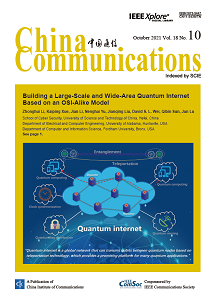具有误差传播的多天线NOMA系统基于群的连续干扰消除
IF 3.1
3区 计算机科学
Q2 TELECOMMUNICATIONS
引用次数: 0
摘要
非正交多址(NOMA)被认为是提高频谱效率和解决大规模连接问题的关键技术。然而,对于功率域NOMA,所需的总发射功率应该随着用户数量的增加而快速增加,以确保信号干扰加噪声比达到预定阈值。此外,由于采用了连续干扰消除(SIC),因此随着SIC阶数的增加,误差传播将变得更加严重。为了最大限度地减少总发射功率并满足每个用户的服务需求,本文提出了一种新的基于组的SIC框架,用于功率域NOMA与多天线技术的深度集成。基于所提出的框架,研究了具有误差传播的上行链路多天线NOMA系统的功率控制和均衡器设计的联合优化,以最小化发射功率消耗。基于均衡器和发射功率系数之间的关系,将原来的问题转化为发射功率优化问题,并通过并行迭代算法进一步解决。仿真结果表明,在总功耗方面,该方案优于传统的OMA和现有的基于集群的NOMA方案。本文章由计算机程序翻译,如有差异,请以英文原文为准。
Group-based successive interference cancellation for multi-antenna NOMA system with error propagation
Non-orthogonal multiple access (NOMA) is viewed as a key technique to improve the spectrum efficiency and solve the issue of massive connectivity. However, for power domain NOMA, the required overall transmit power should be increased rapidly with the increasing number of users in order to ensure that the signal-to-interference-plus-noise ratio reaches a predefined threshold. In addition, since the successive interference cancellation (SIC) is adopted, the error propagation would become more serious as the order of SIC increases. Aiming at minimizing the total transmit power and satisfying each user's service requirement, this paper proposes a novel framework with group-based SIC for the deep integration between power domain NOMA and multi-antenna technology. Based on the proposed framework, a joint optimization of power control and equalizer design is investigated to minimize transmit power consumption for uplink multi-antenna NOMA system with error propagations. Based on the relationship between the equalizer and the transmit power coefficients, the original problem is transformed to a transmit power optimization problem, which is further addressed by a parallel iteration algorithm. It is shown by simulations that, in terms of the total power consumption, the proposed scheme outperforms the conventional OMA and the existing cluster-based NOMA schemes.
求助全文
通过发布文献求助,成功后即可免费获取论文全文。
去求助
来源期刊

China Communications
工程技术-电信学
CiteScore
8.00
自引率
12.20%
发文量
2868
审稿时长
8.6 months
期刊介绍:
China Communications (ISSN 1673-5447) is an English-language monthly journal cosponsored by the China Institute of Communications (CIC) and IEEE Communications Society (IEEE ComSoc). It is aimed at readers in industry, universities, research and development organizations, and government agencies in the field of Information and Communications Technologies (ICTs) worldwide.
The journal's main objective is to promote academic exchange in the ICTs sector and publish high-quality papers to contribute to the global ICTs industry. It provides instant access to the latest articles and papers, presenting leading-edge research achievements, tutorial overviews, and descriptions of significant practical applications of technology.
China Communications has been indexed in SCIE (Science Citation Index-Expanded) since January 2007. Additionally, all articles have been available in the IEEE Xplore digital library since January 2013.
 求助内容:
求助内容: 应助结果提醒方式:
应助结果提醒方式:


